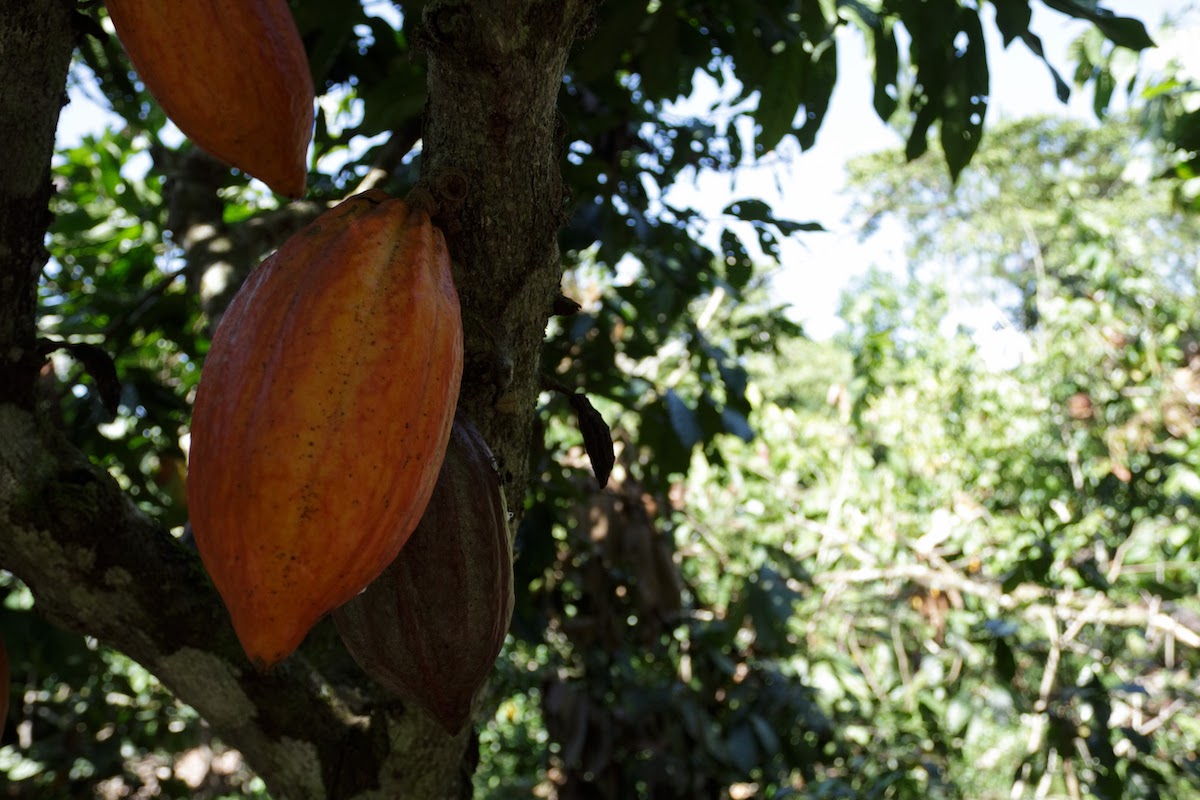
When we started Xocolatl, we weren’t thinking about chocolate as a tool for climate action. We were just two people—one coming from international relief work, the other from political advocacy—who cared deeply about justice, people, and the planet. We were introduced to the concept of bean to bar chocolate by artisan chocolate makers in Costa Rica and fell in love with the flavor of dark chocolate when made in small batches, which was far more flavorful than their mass-produced counterparts we had grown up eating.
The more we learned about chocolate, the more it became clear: this much loved, but not very well understood sweet treat is wrapped up in a much bigger story. One that includes rainforests, farming practices, supply chains, and choices that can either harm or help the environment.

Walking the Forests with Esperanza
At the beginning of our chocolate-making journey, we traveled through the Upper Amazon to visit Esperanza Dionisio, General Manager of CAC Pangoa, a farmer-led coffee and cacao cooperative made up of 700+ small family farmers in the remote region of San Martín de Pangoa in Peru. Esperanza is an agronomist and has been a global leader in sustainable farming practices for decades. As we walked the hilly terrain inside the Amazon rainforest together, she pointed out a stretch of land that had been clear cut to grow pineapples. It was barren. Dry. Hot. Eroded. She explained how pineapple plants strip the soil of nutrients, leaving the land so depleted that farmers have to abandon it after just a couple of years—and move on to clear the next patch of forest.
Then we walked through a cacao farm.
There, beneath a canopy of tall and strong upper story trees and in the dense tangle of the under story where cacao, banana, orange and star fruit trees all grew together in a profusion of color, the air was cool, the soil visibly rich, the biodiversity obvious. Esperanza explained that when done well, growing cacao actually preserves the rainforest—because the highest quality cacao thrives in the shade of well-managed forests, among birdsong, bees, banana trees, and life.
Later that week, as we flew out of the Amazon in a tiny prop plane, we looked down and saw miles of rainforest clear cut for cattle ranching. A future paved in cheap beef and depleted soil.
We realized: cacao could either be part of the problem—or part of the solution.

Choosing to Work with the Forest, Not Against It
From the start, we made a choice to work only with cacao suppliers that farm in harmony with nature. No monoculture plantations. No clear-cutting. No shortcuts.
Some of the partners we’re proud to work with include:
-
CAC Pangoa (Peru) – A member-led co-op that not only grows beautiful, fine-flavor cacao but also operates a reforestation program that protects biodiversity in the upper Amazon.
-
Latitude Cacao (Uganda) – A vertically integrated social enterprise that provides direct support and training to farmers while maintaining fully traceable, sustainable cacao practices.
-
Kokoa Kamili (Tanzania) – A social enterprise that works with smallholder farmers practicing agroforestry—a method of growing cacao among native trees that supports biodiversity and healthier soils.
- Cacao Bisiesto (Nicaragua) – We worked with Cacao Bisiesto and Birds Georgia to create a chocolate bar that highlights the critical winter habitat of our backyard birds, like tanagers and warblers, that depend on the rainforests of Nicaragua—and why we need to help preserve that habitat for our migratory friends.
None of this is a marketing gimmick for Earth Day platitudes—it’s the only way we’re interested in sourcing the cacao for your chocolate.
And yes, shade-grown, expertly tended cacao costs more. But there’s no such thing as cheap chocolate without someone—or something—paying the price.

The True Cost of Chocolate (and Why We Pay It)
Over the past two years, the price of cacao has skyrocketed—and the reason is climate change.
In West Africa, where more than two-thirds of the world’s cocoa is produced, countries like Côte d’Ivoire and Ghana have been battered by alternating floods, droughts, and disease that have devastated multiple harvests. This region has also suffered from decades of underinvestment, largely because the industrial chocolate industry has paid far below the true cost of sustainable cacao.
Let’s be clear: these supply shortages are not a fluke. They’re the beginning of a long-term reckoning.
For years, we’ve paid well above Fair Trade rates for our cacao—often more than double the commodity price. Back in 2021, for instance, we were paying over $4,500 per metric ton, while some “fair” chocolate brands were paying less than half that. This year, with continued global shortages, we’re paying from $9,000 to $13,000 per ton.
One major brand (which we won’t name but which is surely on your local grocery store’s shelves) markets itself as an ethical alternative to Big Chocolate. But if you read their own impact reports, you’ll see that the majority of their cacao farmers still don’t earn a living wage.
We’re not perfect. We’re not trying to score points. But we believe customers deserve to know the difference between chocolate that sounds good and chocolate that does good.

How We Reduce Our Impact at Home
Environmental sustainability in chocolate production isn’t just about where cacao comes from—the other half of the answer comes from the operational choices a chocolate company makes once the cacao arrives.
Here’s what we’re doing behind the scenes at Xocolatl to measure our carbon footprint, improve our operations to reduce that footprint and offset what we can’t reduce:
- We're certified under The Climate Label by Change Climate, which means we track our emissions, set targets, and pay an internal carbon fee to fund climate solutions. Our offsets and removals go to verified projects like Climeworks carbon capture and Pachama forest conservation.
- We pay a premium for Renewable Energy Credits through Georgia Power to ensure 100% of our energy use comes from clean sources—and we avoid gas-powered equipment in favor of electric roasters and stoves.
- We’ve diverted more than 10,000 pounds of food waste from landfills through our partnership with Compost Now—enough to avoid over 26,000 pounds of CO₂ emissions.
- We hand-wrap all of our chocolate bars in recycled and recyclable paper wrappers we had custom-made for us by French Paper, a 100% renewable energy powered paper mill in Michigan.
- Our drinking chocolate, cocoa nibs, trail mix, and cocoa powder are all packaged in home-compostable bags from Elevate Packaging. The remainder of our pantry products are packaged in recyclable glass jars, never plastic.
None of these choices are the cheapest. But they’re the right ones to make for our present and our future.

So, No, You Probably Don’t Need Chocolate for Earth Day
But if you’re going to enjoy some, we hope you’ll choose a chocolate that respects the people and ecosystems that make it possible.
And hey—we’re not claiming that chocolate can save the world. But we are trying to make sure it doesn’t harm our environment. And we want to provide conscious consumers with context to make informed decisions to select chocolate from makers who are truly environmentally conscious—not just greenwashers. We’re not the only small batch chocolate makers committed to environmental sustainability, and we encourage you to explore other makers who share these same values.
Thanks for being on this journey with us. There are easier, cheaper routes towards chocolate, but we’re proud of what we’ve done so far, and grateful to our customers like you, who care.
On Earth Day and every day, let’s get our hands dirty doing the harder, better thing, and enjoy the sweet reward of knowing we’re in it together.`
